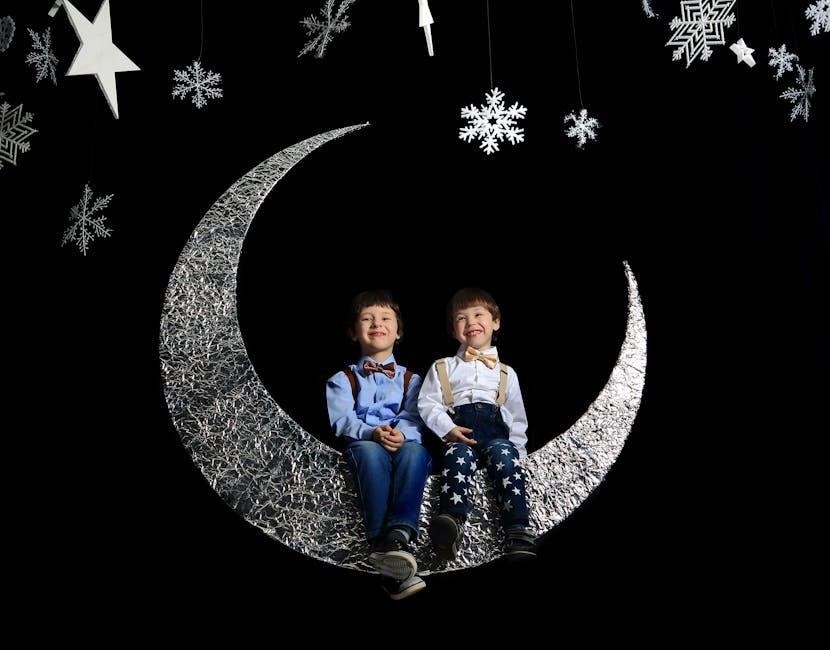grimm brothers cinderella pdf
- by stephany

The Grimm Brothers, Jacob and Wilhelm, were 19th-century German scholars and linguists who collected and published folktales, preserving European cultural heritage. Their Cinderella story, “Aschenputtel,” remains a timeless classic, widely popular in PDF formats today.
Who Were the Grimm Brothers?

Jacob and Wilhelm Grimm were 19th-century German scholars, linguists, and cultural researchers. Born in 1785 and 1786, respectively, they grew up in a family that valued education and literature. The brothers studied law and philology, developing a deep interest in folklore and language. Their collaboration led to the collection of traditional Germanic tales, which they published as Kinder- und Hausmärchen (Children’s and Household Tales). Initially intended as an academic study of folklore, their work gained popularity for its vivid storytelling. The Grimm Brothers’ stories, including “Cinderella” (Aschenputtel), were rooted in European oral traditions, offering insights into cultural and social norms of the time. Their contributions to literature and folklore remain unparalleled, making them two of the most influential figures in the preservation of fairytales. Their work continues to be widely read and adapted, including in PDF formats, ensuring their legacy endures.
Their Contribution to Folklore and Literature
The Grimm Brothers made an indelible mark on folklore and literature by collecting and preserving traditional European tales. Their work, initially intended as an academic study, became a cornerstone of cultural heritage. By compiling stories like “Cinderella” (Aschenputtel), they safeguarded oral traditions that might have otherwise been lost. Their scholarly approach ensured authenticity, while their storytelling captivated audiences worldwide. The Grimm Brothers’ tales, now widely available in formats like PDF, continue to influence literature, film, and art. Their legacy lies in bridging the gap between academic research and popular culture, ensuring that folklore remains accessible and relevant across generations. Their contributions have not only shaped the literary landscape but also deepened understanding of cultural and social history.

The Original Cinderella Story by the Grimm Brothers
The Grimm Brothers’ “Aschenputtel” is a darker, more violent version of Cinderella, reflecting 19th-century German folklore. It emphasizes themes of suffering, transformation, and moral justice, captivating readers in PDF formats.
Title and Publication History
The Grimm Brothers’ Cinderella, titled Aschenputtel in German, was first published in 1812 in their collection Kinder- und Hausmärchen (“Children’s and Household Tales”). The story, also known as “The Little Ash Girl,” reflects its darker, original roots. Over time, the tale has been translated and adapted, with the PDF version becoming a popular format for readers seeking the unaltered narrative. The title Aschenputtel highlights Cinderella’s humble state, covered in ashes from her fireplace labors. This name underscores her transformation from hardship to royalty, a central theme of the story. The Grimm Brothers’ original publication aimed to preserve Germanic folklore, and their Cinderella remains a cornerstone of their legacy, now widely accessible in digital formats like PDF.
Plot Summary of “Aschenputtel”
In the Grimm Brothers’ Aschenputtel, a young girl’s life is marked by tragedy when her mother dies, leaving her in the care of her father and stepmother. The stepmother, cruel and manipulative, forces Cinderella into a life of servitude, reducing her to sleeping in ashes. Despite her hardships, Cinderella remains kind and diligent. When the prince invites all eligible maidens to a grand ball, Cinderella longs to attend but is refused by her stepmother. With the help of her deceased mother’s spirit and magical birds, Cinderella transforms, attending the ball and captivating the prince; She flees before midnight, leaving behind a slipper. The prince searches for the girl whose foot fits the slipper, and after her stepsisters fail, Cinderella proves her identity. The story concludes with Cinderella and the prince marrying, symbolizing her triumph over adversity.
Key Differences from Modern Cinderella Adaptations
The Grimm Brothers’ Aschenputtel differs significantly from modern Cinderella adaptations, offering a darker and more violent narrative. In the original tale, Cinderella’s stepsisters mutilate their feet to fit the slipper, and later, during the wedding, birds peck out their eyes as punishment. Additionally, the story lacks a fairy godmother; instead, Cinderella receives help from her deceased mother’s spirit and magical birds. The prince also plays a less active role compared to modern versions. The Grimm brothers’ story emphasizes moral consequences, with the stepsisters suffering harsh punishments for their cruelty. These elements, often sanitized in modern adaptations, highlight the story’s roots in European folklore and its focus on justice and retribution. The original tale’s darker tone contrasts sharply with the romanticized versions popular today, offering a more somber reflection of life’s hardships.

Themes and Symbolism in Grimm’s Cinderella
Grimm’s Cinderella explores themes of resilience, justice, and transformation. The story symbolizes the struggle between good and evil, with nature and animals playing pivotal roles in Cinderella’s journey.

Moral Lessons and Teachings
Grimm’s Cinderella imparts timeless moral lessons, emphasizing kindness, humility, and patience. Despite her suffering, Cinderella remains virtuous, teaching the value of enduring hardship with grace. The story highlights the consequences of wickedness, as the stepmother and stepsisters face punishment for their cruelty. It also underscores the transformative power of forgiveness and the importance of inner beauty over external appearances. The fairy godmother symbolizes hope and divine intervention, reinforcing the idea that help can arrive in unexpected ways. These moral teachings, intertwined with the story’s dark elements, provide a profound reflection on human nature and the rewards of righteousness. The Grimm brothers’ version of Cinderella serves as a cautionary tale, reminding readers of the enduring power of morality and compassion. Its lessons continue to resonate, making it a valuable resource for ethical education.
The Role of Nature and Animals
In Grimm’s Cinderella, nature and animals play pivotal roles, serving as symbols of hope and moral guidance. The white dove and birds are depicted as Cinderella’s allies, assisting her in times of need and embodying purity and innocence. A tree grows on her mother’s grave, symbolizing life, connection, and the enduring bond between Cinderella and her deceased mother. This tree becomes a source of comfort and strength for Cinderella, highlighting the healing power of nature. Animals, particularly the birds, act as messengers and helpers, reflecting the idea that nature sides with the virtuous. These elements contrast with the harshness of human cruelty, emphasizing the moral lessons of the story. The integration of nature and animals underscores the themes of resilience, kindness, and the interconnectedness of all living beings, making them integral to the narrative’s emotional and symbolic depth.

The Significance of the Ball and Transformation
The ball in Grimm’s Cinderella serves as a pivotal moment of transformation, both literal and symbolic. Cinderella’s magical metamorphosis, facilitated by her fairy godmother, allows her to transcend her mundane life and attend the royal event. The transformation highlights her inner beauty and virtue, which shine through her external appearance. The ball itself represents a space of opportunity and social elevation, where Cinderella’s true worth is recognized by the prince. However, the fleeting nature of the magic underscores the impermanence of external beauty and the importance of inner qualities. The transformation also symbolizes Cinderella’s journey from oppression to liberation, showcasing her resilience and the power of hope. This iconic scene remains central to the story’s enduring appeal, emphasizing the idea that true beauty and worth can transform lives. The ball and Cinderella’s transformation are timeless symbols of self-discovery and redemption.
Character Analysis
The Grimm Brothers’ Cinderella features a cast of vivid characters, including the kind-hearted protagonist, her cruel stepmother and stepsisters, a distant father, a redeeming prince, and a magical fairy godmother.

Cinderella: The Protagonist
Cinderella, or “Aschenputtel” in the Grimm Brothers’ version, is portrayed as a kind, hardworking young woman who endures her stepfamily’s cruelty with patience. Despite her hardships, she remains virtuous and hopeful. Her transformation at the ball symbolizes her inner beauty and resilience. The story highlights her determination and the eventual triumph of good over evil. Cinderella’s character serves as a moral lesson, teaching readers about perseverance and the rewards of kindness. Her journey from ashes to royalty has captivated audiences for generations, making her one of the most beloved protagonists in folklore. The Grimm Brothers’ depiction emphasizes her strength and the transformative power of hope and kindness.
The Evil Stepmother and Stepsisters
The evil stepmother and stepsisters in the Grimm Brothers’ “Aschenputtel” embody cruelty and jealousy, driving the plot with their malicious actions. The stepmother, motivated by selfishness, treats Cinderella with disdain, forcing her into servitude. Her daughters, equally spoiled and vain, mock Cinderella and revel in her misery. Their greed and arrogance lead them to drastic measures, such as cutting off their toes to fit into the magical slipper. The Grimm Brothers use these characters to illustrate the consequences of wickedness and the dangers of envy. Their harsh portrayal serves as a moral warning, contrasting sharply with Cinderella’s virtue. The stepmother and stepsisters’ downfall underscores the story’s theme of justice and the ultimate triumph of goodness. Their roles are pivotal in highlighting Cinderella’s resilience and the moral lessons embedded in the tale.
The Father and His Role in the Story
The father in the Grimm Brothers’ “Aschenputtel” plays a passive yet significant role, often criticized for his lack of involvement in Cinderella’s plight. Despite his wealth and authority, he fails to protect his daughter from her stepmother and stepsisters, showcasing a weakness in character. His absence of action allows the abuse to escalate, making him complicit in Cinderella’s suffering. The father’s passivity serves as a moral lesson, highlighting the importance of parental responsibility and the consequences of indifference. His eventual realization of Cinderella’s worth comes too late, underscoring the theme of justice and the need for accountability. The father’s role, though minor, emphasizes the societal critique embedded in the tale, where even those in power can fail to uphold their duties. This portrayal adds depth to the story, illustrating the broader human flaws that Cinderella must overcome.
The Prince: A Symbol of Redemption
The prince in the Grimm Brothers’ “Aschenputtel” serves as a symbol of redemption, offering Cinderella a path to escape her oppressive life. His character represents hope and deliverance, embodying the idea that true worth can be recognized and rewarded. Unlike modern adaptations, the prince in the original tale is not overly developed but acts as a catalyst for Cinderella’s liberation. His pursuit of her after the ball highlights the transformative power of connection and the possibility of overcoming adversity. The prince’s role underscores the theme of justice, where kindness and virtue ultimately triumph. His presence not only rescues Cinderella but also restores balance to her disrupted life, making him a pivotal figure in her journey toward happiness and fulfillment. The prince’s symbolism extends beyond romance, representing the broader idea of redemption and the triumph of goodness.
The Fairy Godmother and Magical Elements
In the Grimm Brothers’ “Aschenputtel,” the fairy godmother is a central figure who embodies magical intervention, transforming Cinderella’s life. Unlike modern adaptations, the fairy godmother in the original tale is not a constant presence but appears at pivotal moments, such as helping Cinderella attend the ball. The magic in the story is deeply tied to nature, as seen in the enchanted tree that aids Cinderella. This element highlights the connection between the natural world and the supernatural, emphasizing that magic is not just a tool for transformation but also a source of comfort and guidance. The fairy godmother’s role underscores the idea that help can come from unexpected places, offering Cinderella hope and empowerment; The magical elements in the story serve as a catalyst for change, illustrating the power of kindness and the possibility of overcoming adversity through divine or supernatural aid.
Cultural and Historical Context
The Grimm Brothers’ collection of folktales, including “Aschenputtel,” reflects 19th-century German culture and societal norms, preserving European folklore while offering insights into the era’s values and traditions.
The Grimm Brothers’ Influence on European Folklore
The Grimm Brothers significantly shaped European folklore by collecting and publishing traditional tales, ensuring their survival for future generations. Their work, including “Aschenputtel,” preserved cultural heritage and influenced literature globally. By documenting stories like Cinderella, they highlighted the importance of folklore in understanding societal values and traditions. Their efforts not only saved these narratives from fading but also inspired adaptations across various media, making their impact enduring. The Grimm Brothers’ contributions remain vital in academic and cultural studies, offering insights into the historical context of European societies. Their influence extends beyond literature, shaping popular culture and education, ensuring that their collected tales continue to resonate with audiences worldwide.

The Story’s Popularity Across Generations
The Grimm Brothers’ Cinderella, or “Aschenputtel,” has captivated audiences for centuries, transcending time and cultural boundaries. Its enduring popularity stems from universal themes of transformation, hope, and justice, resonating with readers of all ages. The story’s ability to adapt to modern media, such as films, stage productions, and even PDF formats, ensures its relevance in contemporary society. The tale’s moral lessons and magical elements continue to inspire new generations, making it a timeless classic. Its accessibility in PDF form has further widened its reach, allowing readers to engage with the original narrative in a convenient and portable format. The story’s appeal lies in its ability to evoke emotions and spark imagination, solidifying its place as a beloved tale across generations. Its influence on literature, film, and culture underscores its lasting impact on global storytelling traditions.
Adaptations and Interpretations in Modern Media
The Grimm Brothers’ Cinderella has undergone countless adaptations and interpretations in modern media, ensuring its timeless appeal. From Disney’s iconic animated film to contemporary retellings in movies, TV shows, and stage productions, the story continues to evolve while retaining its core themes. The original tale’s darker elements, such as the stepsisters’ mutilation, are often softened in adaptations, reflecting changing societal values. However, the essence of transformation, kindness, and redemption remains intact. The availability of the Grimm Brothers’ Cinderella in PDF format has further facilitated its reach, allowing modern audiences to engage with the original narrative. These adaptations not only honor the brothers’ legacy but also introduce their work to new generations, ensuring the story’s relevance in a rapidly changing world. The tale’s versatility and universal themes make it a favorite for reinterpretation across various media platforms.

The Grimm Brothers’ Cinderella in PDF Format
The Grimm Brothers’ Cinderella, or “Aschenputtel,” is widely available in PDF format, offering a faithful representation of the original tale. Its popularity stems from its accessibility and preservation of the story’s darker, authentic elements. Readers can easily download the PDF from various online platforms, ensuring the story’s enduring reach and relevance. This format has become a preferred way to experience the unaltered version of the classic narrative.
Why the PDF Version is Popular
The PDF version of Grimm’s Cinderella, or “Aschenputtel,” remains highly popular due to its accessibility and faithful representation of the original tale. Readers appreciate the convenience of downloading the story in a format that preserves its authentic, darker elements. The PDF is widely available online, making it easy for audiences to access the unaltered version of the classic narrative. Its digital format ensures that the story reaches a broader audience, including younger generations and scholars. Additionally, the PDF retains the original structure and language, appealing to those interested in the story’s historical and cultural significance. This format has become a preferred way to experience the tale without the alterations found in modern adaptations, ensuring its enduring relevance in a digital age.
Where to Find the Grimm Brothers’ Cinderella PDF
The Grimm Brothers’ Cinderella, or “Aschenputtel,” is widely available in PDF format across various online platforms. Readers can easily download the story from websites like Project Gutenberg, Google Books, and ManyBooks, which offer free access to classic literature. Additionally, academic and literary databases often include the PDF version of Grimm’s original tales. Some websites, such as those dedicated to folklore and fairytales, provide downloadable links for “Aschenputtel” in multiple languages. The PDF is also accessible through online libraries and e-book platforms, ensuring its availability to a global audience. These sources allow readers to explore the unedited, darker version of Cinderella, preserving the Grimm Brothers’ authentic narrative. The ease of access and free availability make the PDF a popular choice for both casual readers and scholars.
Benefits of Reading the Original Version
Reading the original version of Grimm’s Cinderella, “Aschenputtel,” offers a unique opportunity to experience the story in its authentic form, untouched by modern adaptations. The original tale provides a deeper understanding of the moral and cultural context in which it was written. Unlike sanitized versions, the Grimm Brothers’ story retains its darker elements, such as the stepsisters mutilating their feet and the birds punishing the wicked. This raw narrative highlights the brothers’ intent to convey harsh moral lessons and the realities of life in 19th-century Europe. The original version also preserves the linguistic and stylistic nuances of the Grimm Brothers’ writing, making it a valuable resource for literary analysis. For scholars and enthusiasts alike, reading the original “Aschenputtel” in PDF format allows for a more immersive and educational experience, connecting readers to the roots of European folklore.

Educational Value of the Grimm Brothers’ Cinderella
The Grimm Brothers’ Cinderella offers rich educational value, teaching moral lessons, cultural heritage, and critical thinking. Its original form encourages deeper analysis of societal norms and historical contexts.
Teaching Moral Values Through the Story
The Grimm Brothers’ Cinderella is a powerful tool for teaching moral values. The story emphasizes kindness, perseverance, and humility, as Cinderella remains virtuous despite her hardships. Her patience and integrity ultimately lead to her triumph, illustrating the reward of good behavior. The tale also highlights the consequences of cruelty and greed through the stepmother and stepsisters, serving as a cautionary lesson. These moral lessons are timeless, making the story a valuable resource for educating children and adults alike. The original PDF version of “Aschenputtel” preserves these teachings, offering a raw and impactful narrative that fosters reflection on ethical behavior and personal growth.
Analyzing the Story for Academic Purposes
The Grimm Brothers’ Cinderella, or “Aschenputtel,” offers rich material for academic analysis. Scholars often explore its themes of social hierarchy, gender roles, and moral justice. The story’s darker elements, such as the stepsisters mutilating their feet, provide insight into the harsh realities of 19th-century European society. The tale also invites psychological analysis, particularly in its portrayal of Cinderella’s resilience and the stepmother’s cruelty. The original PDF versions of the story, like those translated by Jacob and Wilhelm Grimm, are invaluable for close reading and textual analysis. They preserve the narrative’s raw, unfiltered nature, allowing researchers to study the cultural and historical contexts that shaped the tale. Additionally, the story’s evolution over time, from its folkloric roots to modern adaptations, makes it a fascinating subject for comparative studies. This depth ensures its relevance in academic settings, fostering critical thinking and interdisciplinary exploration.
The Story’s Relevance in Modern Education
The Grimm Brothers’ Cinderella remains a vital tool in modern education, offering lessons beyond its fairy tale surface. Its exploration of moral values, resilience, and social dynamics aligns with contemporary educational goals. The story’s themes of kindness, perseverance, and justice resonate with students, fostering empathy and critical thinking. The original PDF versions, such as “Aschenputtel,” provide a raw, unfiltered narrative that encourages students to analyze historical contexts and cultural evolution; Educators use the tale to teach literary analysis, comparative studies, and the impact of storytelling on society. Its universal appeal makes it accessible across age groups, from elementary to university levels. By studying the Grimm Brothers’ Cinderella, students gain insights into folklore’s role in preserving cultural heritage and its adaptation across generations, enriching their understanding of literature and history. This relevance ensures the story’s continued presence in educational curricula worldwide.
The Grimm Brothers’ Cinderella, in its original form, leaves a lasting impact, blending magic with moral lessons. Its timeless appeal ensures its relevance, captivating readers across generations in PDF formats.
The Enduring Legacy of Grimm’s Cinderella
Grimm’s Cinderella, or “Aschenputtel,” has left an indelible mark on global culture, transcending time and mediums. Its dark, original tale, preserved in PDF formats, continues to captivate readers with its raw authenticity. The story’s exploration of human nature, morality, and transformation resonates universally, making it a cornerstone of folklore. Its influence extends beyond literature, inspiring countless adaptations in film, theater, and art. The Grimm Brothers’ version, with its vivid imagery and moral depth, remains a vital resource for scholars and enthusiasts alike. Its enduring popularity underscores the timeless appeal of a narrative that blends magic with harsh realities, ensuring its relevance for future generations. The PDF format has further cemented its accessibility, allowing readers to engage with the original tale in its purest form. Grimm’s Cinderella is not just a story but a cultural phenomenon, bridging the past and present.
Final Thoughts on the Story’s Impact
Grimm’s Cinderella, as seen in the PDF versions, has profoundly shaped cultural narratives, offering insights into societal values and human resilience. Its themes of hope, justice, and transformation continue to inspire diverse adaptations, from films to stage productions. The story’s ability to evolve while retaining its core message ensures its relevance across generations. The Grimm Brothers’ original tale, with its darker elements, provides a stark contrast to modern adaptations, highlighting the adaptability of folklore. As a result, “Aschenputtel” remains a vital part of educational and cultural discourse, fostering critical thinking and emotional connection. Its impact is undeniable, cementing its place as a timeless classic that bridges past and present, ensuring its enduring influence on literature and media. The Grimm Brothers’ Cinderella is not just a story but a reflection of human experience, resonating deeply with audiences worldwide.
Related posts:
Download the classic Grimm Brothers Cinderella PDF for a timeless fairy tale experience. Free and ready to read!
Posted in PDF